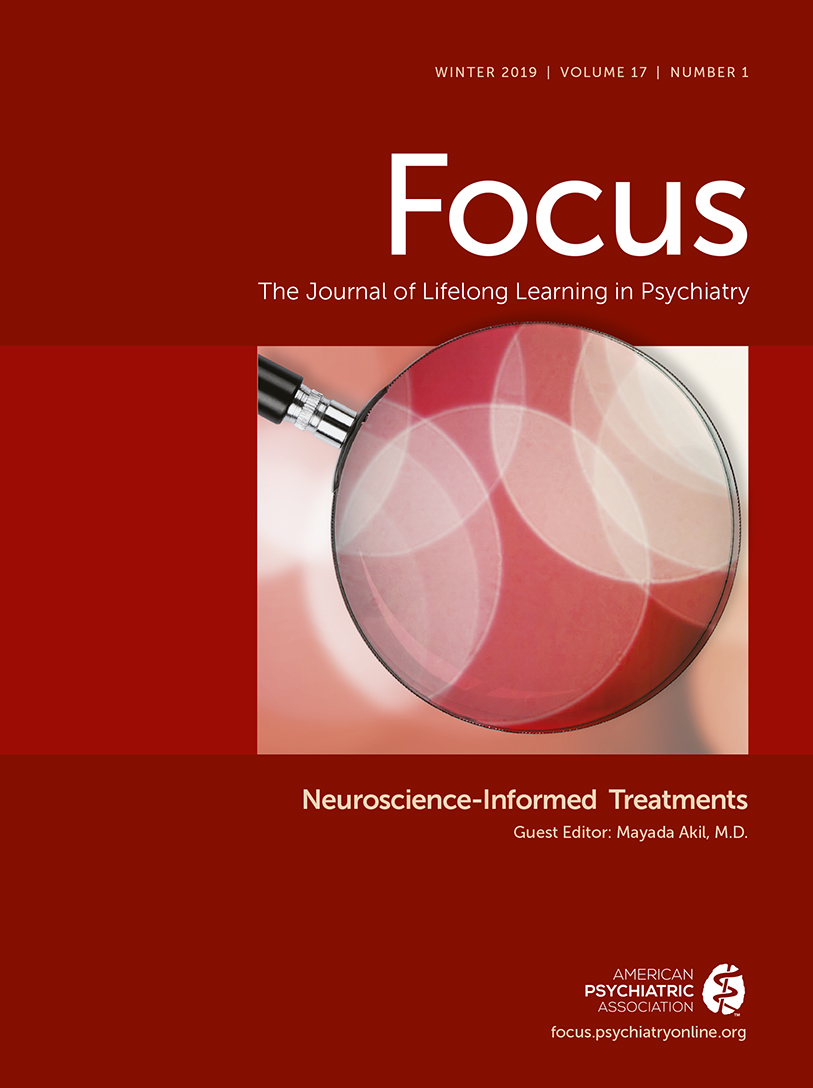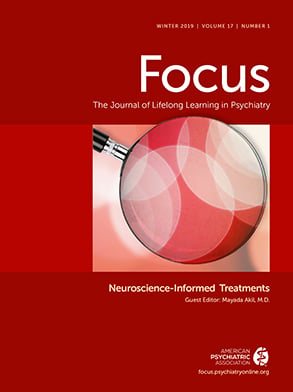Neuroscientifically Informed Formulation and Treatment Planning for Patients With Obsessive-Compulsive Disorder: A Review
Dougherty DD, Brennan BP, Stewart SE, et al.
JAMA Psychiatry 2018; 75(10):1081–1087
IMPORTANCE: Obsessive-compulsive disorder (OCD) is a common and often debilitating psychiatric illness. Recent advances in the understanding of the neuroscience of OCD have provided valuable insights that have begun to transform the way we think about the management of this disorder. This educational review provides an integrated neuroscience perspective on formulation and treatment planning for patients with OCD. The article is organized around key neuroscience themes most relevant for OCD.
OBSERVATIONS: An integrated neuroscience formulation of OCD is predicated on a fundamental understanding of phenomenology and symptom dimensions, fear conditioning and extinction, neurochemistry, genetics and animal models, as well as neurocircuitry and neurotherapeutics. Symptom dimensions provide a means to better understand the phenotypic heterogeneity within OCD with an eye toward more personalized treatments. The concept of abnormal fear extinction is central to OCD and to the underlying therapeutic mechanism of exposure and response prevention. A framework for understanding the neurochemistry of OCD focuses on both traditional monoaminergic systems and more recent evidence of glutamatergic and γ-aminobutyric acid-ergic dysfunction. Obsessive-compulsive disorder is highly heritable, and future work is needed to understand the contribution of genes to underlying pathophysiology. A circuit dysregulation framework focuses on cortico-striato-thalamo-cortical circuit dysfunction and the development of neurotherapeutic approaches targeting this circuit. The impact of these concepts on how we think about OCD diagnosis and treatment is discussed. Suggestions for future investigations that have the potential to further enhance the clinical management of OCD are presented.
CONCLUSIONS AND RELEVANCE: These key neuroscience themes collectively inform formulation and treatment planning for patients with OCD. The ultimate goal is to increase crosstalk between clinicians and researchers in an effort to facilitate translation of advances in neuroscience research to improved care for patients with OCD.
Reprinted with permission from the American Medical Association.
Side-Effects Associated With Ketamine Use in Depression: A Systematic Review
Short B, Fong J, Galvez V, Shelker W, Loo CK
Lancet Psychiatry 2018; 5(1):65–78
This is the first systematic review of the safety of ketamine in the treatment of depression after single and repeated doses. We searched MEDLINE, PubMed, PsycINFO, and Cochrane Databases and identified 288 articles, 60 of which met the inclusion criteria. After acute dosing, psychiatric, psychotomimetic, cardiovascular, neurological, and other side-effects were more frequently reported after ketamine treatment than after placebo in patients with depression. Our findings suggest a selective reporting bias with limited assessment of long-term use and safety and after repeated dosing, despite these being reported in other patient groups exposed to ketamine (e.g. those with chronic pain) and in recreational users. We recommend large-scale clinical trials that include multiple doses of ketamine and long-term follow up to assess the safety of long-term regular use.
Copyright 2018. Reprinted with permission from Elsevier.
Neuroscience of Addiction: Relevance to Prevention and Treatment
Volkow ND, Boyle M.
Am J Psychiatry 2018; 175(8):729–740
Addiction, the most severe form of substance use disorder, is a chronic brain disorder molded by strong biosocial factors that has devastating consequences to individuals and to society. Our understanding of substance use disorder has advanced significantly over the last 3 decades in part due to major progress in genetics and neuroscience research and to the development of new technologies, including tools to interrogate molecular changes in specific neuronal populations in animal models of substance use disorder, as well as brain imaging devices to assess brain function and neurochemistry in humans. These advances have illuminated the neurobiological processes through which biological and sociocultural factors contribute to resilience against or vulnerability for drug use and addiction. The delineation of the neurocircuitry disrupted in addiction, which includes circuits that mediate reward and motivation, executive control, and emotional processing, has given us an understanding of the aberrant behaviors displayed by addicted individuals and has provided new targets for treatment. Most prominent are the disruptions of an individual's ability to prioritize behaviors that result in long-term benefit over those that provide short-term rewards and the increasing difficulty exerting control over these behaviors even when associated with catastrophic consequences. These advances in our understanding of brain development and of the role of genes and environment on brain structure and function have built a foundation on which to develop more effective tools to prevent and treat substance use disorder.
Reprinted with permission from American Psychiatric Association Publishing.
Changes in Brain Connectivity During a Sham Controlled, Transcranial Magnetic Stimulation Trial for Depression
Taylor SF, Ho SS, Abagis T, et al.
J Affect Disord 2018; 232:143–151
BACKGROUND: The subgenual anterior cingulate cortex (sgACC) has been implicated in major depressive disorder (MDD), and this study evaluated sgACC connectivity before and after repetitive transcranial magnetic stimulation (rTMS) treatment.
METHODS: Thirty-two MDD patients entered a sham-controlled, double-blinded, randomized trial of rTMS to the left dorsolateral prefrontal cortex (dlFPC). Subjects underwent resting state functional magnetic resonance imaging before and after 20 sessions of high frequency rTMS. Seed voxels identified the affective network (AN; sgACC, amygdala), default mode network (DMN; posterior cingulate cortex [PCC]), and fronto-parietal network (FPN; dlPFC stimulation site).
RESULTS: There was no significant effect of active rTMS over sham on the primary outcome measure (Montgomery-Asberg Depression Scale rating), with both groups improving over time, and no specific effect of rTMS (sham versus active) on connectivity. However, among patients who showed significant improvement, sgACC connectivity decreased for sham (to AN, trend to DMN) and active rTMS responders (to AN, DMN, FPN), but not in nonresponders, who tended to maintain connectivity. Including subjects who started with sham but then received open-label active treatment, baseline connectivity from the PCC to the anterior insula was greater in nonresponders compared with responders (n = 27, excluding 5 sham responders).
LIMITATIONS: The sample size was small; the stimulation target was nonstandard, and the lack of a significant clinical effect of rTMS limits conclusions about negative findings.
CONCLUSIONS: sgACC connectivity reduces along with depressive symptoms, not specific to rTMS therapy. Altered connectivity of DMN with anterior insula may reflect a type of patient less likely to respond to an intervention.
Copyright 2018. Reprinted with permission from Elsevier.
Using FMRI and Machine Learning to Predict Symptom Improvement Following Cognitive Behavioural Therapy for Psychosis
Tolmeijer E, Kumari V, Peters E, et al.
Neuroimage Clin 2018; 20:1053–1061
Cognitive behavioral therapy for psychosis (CBTp) involves helping patients to understand and reframe threatening appraisals of their psychotic experiences to reduce distress and increase functioning. While CBTp is effective for many, it is not effective for all patients and the factors predicting a good outcome remain poorly understood. Machine learning is a powerful approach that allows new predictors to be identified in a data-driven way, which can inform understanding of the mechanisms underlying therapeutic interventions, and ultimately make predictions about symptom improvement at the individual patient level. Thirty-eight patients with a diagnosis of schizophrenia completed a social affect task during functional MRI. Multivariate pattern analysis assessed whether treatment response in those receiving CBTp (n = 22) could be predicted by pretherapy neural responses to facial affect that was either threat-related (ambiguous 'neutral' faces perceived as threatening in psychosis, in addition to angry and fearful faces) or prosocial (happy faces). The models predicted improvement in psychotic (r = 0.63, p = 0.003) and affective (r = 0.31, p = 0.05) symptoms following CBTp, but not in the treatment-as-usual group (n = 16). Psychotic symptom improvement was predicted by neural responses to threat-related affect across sensorimotor and frontal-limbic regions, whereas affective symptom improvement was predicted by neural responses to fearful faces only as well as prosocial affect across sensorimotor and frontal regions. These findings suggest that CBTp most likely improves psychotic and affective symptoms in those endorsing more threatening appraisals and mood-congruent processing biases, respectively, which are explored and reframed as part of the therapy. This study improves our understanding of the neurobiology of treatment response and provides a foundation that will hopefully lead to greater precision and tailoring of the interventions offered to patients.
Meta-Analyses of the Neural Mechanisms and Predictors of Response to Psychotherapy in Depression and Anxiety
Marwood L, Wise T, Perkins AM, et al.
Neurosci Biobehav Rev 2018; 95:61–72
Understanding the neural mechanisms underlying psychological therapy could aid understanding of recovery processes and help target treatments. The dual-process model hypothesizes that psychological therapy is associated with increased emotional-regulation in prefrontal brain regions and decreased implicit emotional-reactivity in limbic regions; however, research has yielded inconsistent findings. Meta-analyses of brain activity changes accompanying psychological therapy (22 studies, n=352) and neural predictors of symptomatic improvement (11 studies, n=293) in depression and anxietywere conducted using seed-based d mapping. Both resting-state and task-based studies were included, and analyzed together and separately. The most robust findings were significant decreases in anterior cingulate/paracingulate gyrus, inferior frontal gyrus and insula activation after therapy. Cuneus activation was predictive of subsequent symptom change. The results are in agreement with neural models of improved emotional-reactivity following therapy as evidenced by decreased activity within the anterior cingulate and insula. We propose compensatory as well as corrective neuralmechanisms of action underlie therapeutic efficacy, and suggest the dual-process model may be too simplistic to account fully for treatment mechanisms. More research on predictors of psychotherapeutic response is required to provide reliable predictors of response.
An Integrated Neuroscience Perspective on Formulation and Treatment Planning for Posttraumatic Stress Disorder: An Educational Review
Ross DA, Arbuckle MR, Travis MJ, Dwyer JB, van Schalkwyk GI, Ressler KJ.
JAMA Psychiatry 2017; 74(4):407–415
IMPORTANCE: Posttraumatic stress disorder (PTSD) is a common psychiatric illness, increasingly in the public spotlight in the United States due its prevalence in the soldiers returning from combat in Iraq and Afghanistan. This educational review presents a contemporary approach for how to incorporate a modern neuroscience perspective into an integrative case formulation. The article is organized around key neuroscience “themes” most relevant for PTSD. Within each theme, the article highlights how seemingly diverse biological, psychological, and social perspectives all intersect with our current understanding of neuroscience.
OBSERVATIONS: Any contemporary neuroscience formulation of PTSD should include an understanding of fear conditioning, dysregulated circuits, memory reconsolidation, epigenetics, and genetic factors. Fear conditioning and other elements of basic learning theory offer a framework for understanding how traumatic events can lead to a range of behaviors associated with PTSD. A circuit dysregulation framework focuses more broadly on aberrant network connectivity, including between the prefrontal cortex and limbic structures. In the process of memory reconsolidation, it is now clear that every time a memory is reactivated it becomes momentarily labile-with implications for the genesis, maintenance, and treatment of PTSD. Epigenetic changes secondary to various experiences, especially early in life, can have long-term effects, including on the regulation of the hypothalamic-pituitary-adrenal axis, thereby affecting an individual's ability to regulate the stress response. Genetic factors are surprisingly relevant: PTSD has been shown to be highly heritable despite being definitionally linked to specific experiences. The relevance of each of these themes to current clinical practice and its potential to transform future care are discussed.
CONCLUSIONS AND RELEVANCE: Together, these perspectives contribute to an integrative, neuroscience-informed approach to case formulation and treatment planning. This may help to bridge the gap between the traditionally distinct viewpoints of clinicians and researchers.
Reprinted with permission from the American Medical Association.

